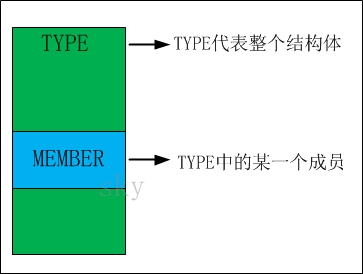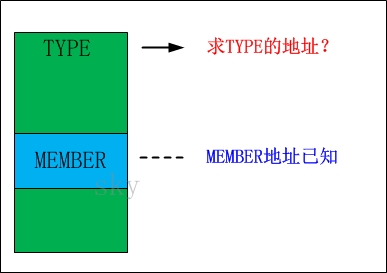本章介绍Linux内核中双向链表及其相关知识(offsetof和container_of两个宏)。
Linux中的两个经典宏定义
倘若你查看过Linux Kernel的源码,那么你对offsetof和container_of这两个宏应该不陌生。
1. offsetof
定义:offsetof在linux内核的include/linux/stddef.h中定义。
#define offsetof(TYPE, MEMBER) ((size_t) &((TYPE *)0)->MEMBER)
说明:获得结构体(TYPE)的变量成员(MEMBER)在此结构体中的偏移量。
- ( (TYPE *)0 ) 将零转型为TYPE类型指针,即TYPE类型的指针的地址是0。
- ((TYPE *)0)->MEMBER 访问结构中的数据成员。
- &( ( (TYPE *)0 )->MEMBER ) 取出数据成员的地址。由于TYPE的地址是0,这里获取到的地址就是相对MEMBER在TYPE中的偏移。
- (size_t)(&(((TYPE*)0)->MEMBER)) 结果转换类型。对于32位系统而言,size_t是unsigned int类型;对于64位系统而言,size_t是unsigned long类型。
示例(offset_test.c):
#include <stdio.h>
// 获得结构体(TYPE)的变量成员(MEMBER)在此结构体中的偏移量。
#define offsetof(TYPE, MEMBER) ((size_t) &((TYPE *)0)->MEMBER)
struct student
{
char gender;
int id;
int age;
char name[20];
};
void main()
{
int gender_offset, id_offset, age_offset, name_offset;
gender_offset = offsetof(struct student, gender);
id_offset = offsetof(struct student, id);
age_offset = offsetof(struct student, age);
name_offset = offsetof(struct student, name);
printf("gender_offset = %d\n", gender_offset);
printf("id_offset = %d\n", id_offset);
printf("age_offset = %d\n", age_offset);
printf("name_offset = %d\n", name_offset);
}
结果:
gender_offset = 0
id_offset = 4
age_offset = 8
name_offset = 12
说明:
简单说说"为什么id的偏移值是4,而不是1"。我的运行环境是linux系统,32位的x86架构。这就意味着cpu的数据总线宽度为32,每次能够读取4字节数据。gcc对代码进行处理的时候,是按照4字节对齐的;这是为了加快处理速度!
offsetof图解

TYPE是结构体,它代表"整体";而MEMBER是成员,它是整体中的某一部分。
将offsetof看作一个数学问题来看待,问题就相当简单了:已知'整体'和该整体中'某一个部分',而计算该部分在整体中的偏移。
2. container_of
定义:container_of在linux内核的include/linux/kernel.h中定义。
#define container_of(ptr, type, member) ({ \
const typeof( ((type *)0)->member ) *__mptr = (ptr); \
(type *)( (char *)__mptr - offsetof(type,member) );})
说明:根据"结构体(type)变量"中的"域成员变量(member)的指针(ptr)"来获取指向整个结构体变量的指针。
- typeof( ( (type *)0)->member ) 取出member成员的变量类型。
- const typeof( ((type )0)->member ) __mptr = (ptr) 定义变量__mptr指针,并将ptr赋值给__mptr。经过这一步,__mptr为member数据类型的常量指针,其指向ptr所指向的地址。
- (char *)__mptr 将__mptr转换为字节型指针。
- offsetof(type,member)) 就是获取"member成员"在"结构体type"中的位置偏移。
- (char *)__mptr - offsetof(type,member)) 就是用来获取"结构体type"的指针的起始地址(为char *型指针)。
- (type )( (char )__mptr - offsetof(type,member) ) 就是将"char 类型的结构体type的指针"转换为"type 类型的结构体type的指针"。
示例(container_test.c):
#include <stdio.h>
#include <string.h>
// 获得结构体(TYPE)的变量成员(MEMBER)在此结构体中的偏移量。
#define offsetof(TYPE, MEMBER) ((size_t) &((TYPE *)0)->MEMBER)
// 根据"结构体(type)变量"中的"域成员变量(member)的指针(ptr)"来获取指向整个结构体变量的指针
#define container_of(ptr, type, member) ({ \
const typeof( ((type *)0)->member ) *__mptr = (ptr); \
(type *)( (char *)__mptr - offsetof(type,member) );})
struct student
{
char gender;
int id;
int age;
char name[20];
};
void main()
{
struct student stu;
struct student *pstu;
stu.gender = '1';
stu.id = 9527;
stu.age = 24;
strcpy(stu.name, "zhouxingxing");
// 根据"id地址" 获取 "结构体的地址"。
pstu = container_of(&stu.id, struct student, id);
// 根据获取到的结构体student的地址,访问其它成员
printf("gender= %c\n", pstu->gender);
printf("age= %d\n", pstu->age);
printf("name= %s\n", pstu->name);
}
结果:
gender= 1
age= 24
name= zhouxingxing
container_of图解

type是结构体,它代表"整体";而member是成员,它是整体中的某一部分,而且member的地址是已知的。
将offsetof看作一个数学问题来看待,问题就相当简单了:已知'整体'和该整体中'某一个部分',要根据该部分的地址,计算出整体的地址。
Linux中双向链表的经典实现
Linux双向链表的定义主要涉及到两个文件:
- include/linux/types.h
- include/linux/list.h
Linux中双向链表的使用思想
它是将双向链表节点嵌套在其它的结构体中;在遍历链表的时候,根据双链表节点的指针获取"它所在结构体的指针",从而再获取数据。
我举个例子来说明,可能比较容易理解。
假设存在一个社区中有很多人,每个人都有姓名和年龄。通过双向链表将人进行关联的模型图如下:

person代表人,它有name和age属性。为了通过双向链表对person进行链接,我们在person中添加了list_head属性。通过list_head,我们就将person关联起来了。
1. 节点定义
struct list_head {
struct list_head *next, *prev;
};
虽然名称list_head,但是它既是双向链表的表头,也代表双向链表的节点。
2. 初始化节点
#define LIST_HEAD_INIT(name) { &(name), &(name) }
#define LIST_HEAD(name) \
struct list_head name = LIST_HEAD_INIT(name)
static inline void INIT_LIST_HEAD(struct list_head *list)
{
list->next = list;
list->prev = list;
}
LIST_HEAD的作用是定义表头(节点):新建双向链表表头name,并设置name的前继节点和后继节点都是指向name本身。
LIST_HEAD_INIT的作用是初始化节点:设置name节点的前继节点和后继节点都是指向name本身。
INIT_LIST_HEAD和LIST_HEAD_INIT一样,是初始化节点:将list节点的前继节点和后继节点都是指向list本身。
3. 添加节点
static inline void __list_add(struct list_head *new,
struct list_head *prev,
struct list_head *next)
{
next->prev = new;
new->next = next;
new->prev = prev;
prev->next = new;
}
static inline void list_add(struct list_head *new, struct list_head *head)
{
__list_add(new, head, head->next);
}
static inline void list_add_tail(struct list_head *new, struct list_head *head)
{
__list_add(new, head->prev, head);
}
__list_add(new, prev, next)的作用是添加节点:将new插入到prev和next之间。在linux中,以"__"开头的函数意味着是内核的内部接口,外部不应该调用该接口。
list_add(new, head)的作用是添加new节点:将new添加到head之后,是new称为head的后继节点。
list_add_tail(new, head)的作用是添加new节点:将new添加到head之前,即将new添加到双链表的末尾。
4. 删除节点
static inline void __list_del(struct list_head * prev, struct list_head * next)
{
next->prev = prev;
prev->next = next;
}
static inline void list_del(struct list_head *entry)
{
__list_del(entry->prev, entry->next);
}
static inline void __list_del_entry(struct list_head *entry)
{
__list_del(entry->prev, entry->next);
}
static inline void list_del_init(struct list_head *entry)
{
__list_del_entry(entry);
INIT_LIST_HEAD(entry);
}
__list_del(prev, next) 和__list_del_entry(entry)都是linux内核的内部接口。
__list_del(prev, next) 的作用是从双链表中删除prev和next之间的节点。
__list_del_entry(entry) 的作用是从双链表中删除entry节点。
list_del(entry) 和 list_del_init(entry)是linux内核的对外接口。 list_del(entry) 的作用是从双链表中删除entry节点。list_del_init(entry) 的作用是从双链表中删除entry节点,并将entry节点的前继节点和后继节点都指向entry本身。
5. 替换节点
static inline void list_replace(struct list_head *old,
struct list_head *new)
{
new->next = old->next;
new->next->prev = new;
new->prev = old->prev;
new->prev->next = new;
}
list_replace(old, new)的作用是用new节点替换old节点。
6. 判断双链表是否为空
static inline int list_empty(const struct list_head *head)
{
return head->next == head;
}
list_empty(head)的作用是判断双链表是否为空。它是通过区分"表头的后继节点"是不是"表头本身"来进行判断的。
7. 获取节点
#define list_entry(ptr, type, member) \
container_of(ptr, type, member)
list_entry(ptr, type, member) 实际上是调用的container_of宏。它的作用是:根据"结构体(type)变量"中的"域成员变量(member)的指针(ptr)"来获取指向整个结构体变量的指针。
8. 遍历节点
#define list_for_each(pos, head) \
for (pos = (head)->next; pos != (head); pos = pos->next)
#define list_for_each_safe(pos, n, head) \
for (pos = (head)->next, n = pos->next; pos != (head); \
pos = n, n = pos->next)
list_for_each(pos, head)和list_for_each_safe(pos, n, head)的作用都是遍历链表。但是它们的用途不一样!
list_for_each(pos, head)通常用于获取节点,而不能用到删除节点的场景。
list_for_each_safe(pos, n, head)通常删除节点的场景。
Linux中双向链表的源码
我将linux中双链表移植出来了,点击查看:Linux双链表源码和测试程序